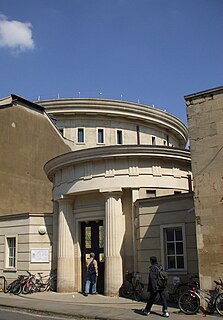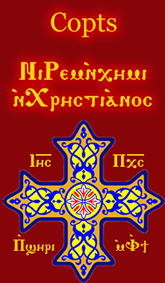
The Coptic Orthodox Church of Alexandria is an Oriental Orthodox Christian church based in Egypt, Africa and the Middle East. The head of the Church and the See of Alexandria is the Patriarch of Alexandria on the Holy See of Saint Mark, who also carries the title of Coptic Pope. The See of Alexandria is titular, and today the Coptic Pope presides from Saint Mark's Coptic Orthodox Cathedral in the Abbassia District in Cairo. The church follows the Alexandrian Rite for its liturgy, prayer and devotional patrimony. With 18–22 million members worldwide, whereof about 15 to 20 million are in Egypt, it is the country's largest Christian church.

Nag Hammadi is a city in Upper Egypt. It is located on the west bank of the Nile in the Qena Governorate, about 80 kilometres north-west of Luxor. It had a population of close to 43,000 as of 2007.

The Egyptian language was spoken in ancient Egypt and was a branch of the Afro-Asiatic languages. Its attestation stretches over an extraordinarily long time, from the Old Egyptian stage. Its earliest known complete written sentence has been dated to about 2690 BC, which makes it one of the oldest recorded languages known, along with Sumerian.

The Copts are an ethnoreligious group indigenous to Northeast Africa who primarily inhabit the area of modern Egypt, where they are the largest Christian denomination in the country. Copts are also the largest Christian denomination in Sudan and Libya. Historically, they spoke the Coptic language, a direct descendant of the Demotic Egyptian that was spoken in late antiquity. While the vast majority of Copts are of Egyptian ancestry, North Africans and Northeast Africans who have converted to the religion also identify as such.

Coptology is the science of Coptic studies, the study of Coptic language and literature.

The National Library of India on the Belvedere Estate in Alipore, Kolkata, is the largest library in India by volume, and India's library of public record. It is under the Ministry of Culture, Government of India. The library is designated to collect, disseminate and preserve printed material produced in India. The library is situated on the scenic 30-acre (12 ha) Belvedere Estate. It is the largest in India with a collection in excess of 2.2 million books. Before independence, it was the official residence of Governor-General of India.

The Herbert D. Katz Center for Advanced Judaic Studies at the University of Pennsylvania is the world's first and only institution exclusively dedicated to post-doctoral research on Jewish Civilization. It hosts one of the country's most noted interdisciplinary post-doctoral fellowship programs. The center is located at 420 Walnut Street between S. 4th and S. 5th Streets in the Old City, Philadelphia neighborhood of Philadelphia. The center is directed by Professor Steven Weitzman.

The Morgan Library & Museum – formerly the Pierpont Morgan Library – is a museum and research library located at 225 Madison Avenue at East 36th Street in the Murray Hill neighborhood of Manhattan, New York City. It was founded to house the private library of J. P. Morgan in 1906, which included manuscripts and printed books, some of them in rare bindings, as well as his collection of prints and drawings. The library was designed by Charles McKim of the firm of McKim, Mead and White and cost $1.2 million. It was made a public institution in 1924 by J. P. Morgan's son John Pierpont Morgan, Jr., in accordance with his father's will.

The Sackler Library holds a large portion of the classical, art historical, and archaeological works belonging to the University of Oxford, England.
Sir Ernest Alfred Thompson Wallis Budge was an English Egyptologist, Orientalist, and philologist who worked for the British Museum and published numerous works on the ancient Near East. He made numerous trips to Egypt and the Sudan on behalf of the British Museum to buy antiquities, and helped it build its collection of cuneiform tablets, manuscripts, and papyri. He published many books on Egyptology, helping to bring the findings to larger audiences. In 1920, he was knighted for his service to Egyptology and the British Museum.

Coptic music is the music sung and played in the Coptic Orthodox Church. It consists mainly of chanted hymns in rhythm with instruments such as cymbals and the triangle. Coptic music is purely religious.

There are a number of languages spoken in Egypt, but Egyptian Arabic or Masry which literally means Egyptian, is by far the most widely spoken in the country.
Iona Margaret Balfour Opie, and Peter Mason Opie were an English married team of folklorists, who applied modern techniques to children's literature, summarised in their studies The Oxford Dictionary of Nursery Rhymes (1951) and The Lore and Language of Schoolchildren (1959). They were also noted anthologists, and assembled large collections of children's literature, toys, and games.

The immigration of the Copts to Canada might have started as early as the late 1950s. Due to an increasing amount of discrimination towards Copts in Egypt in the 1970s and low income in Egypt. Canada has been receiving a greater number of these immigrants, and the number of Coptic immigrants into Canada has been growing ever since.

There have been many Coptic versions of the Bible, including some of the earliest translations into any language. Several different versions were made in the ancient world, with different editions of the Old and New Testament in all four of the major dialects of Coptic: Bohairic (northern), Fayyumic, Sahidic (southern), Akhmimic, and Mesokemic. Biblical books were translated from the Alexandrian Greek version.

Coptic literature is the body of writings in the Coptic language of Egypt, the last stage of the indigenous Egyptian language. It comprises mostly Christian texts dating after the 2nd century AD, but also includes Old Coptic writings that predate the Christian era.
The Coptic Encyclopedia is an eight-volume work covering the history, theology, language, art, architecture, archeology and hagiography of Coptic Egypt. The encyclopedia was written by over 250 Western and Egyptian contributing experts in the field of Coptology, history, art and theology and was edited by Aziz Suryal Atiya. It was funded by Coptic Pope Shenouda III, the Rockefeller Foundation, the National Endowment for the Humanities, and others.

The British Library is the national library of the United Kingdom and the largest national library in the world by number of items catalogued. It is estimated to contain 170–200 million+ items from many countries. As a legal deposit library, the British Library receives copies of all books produced in the United Kingdom and Ireland, including a significant proportion of overseas titles distributed in the UK. The Library is a non-departmental public body sponsored by the Department for Culture, Media and Sport.

Deir el-Muharraq, is also known as the Muharraq Monastery, Burned Monastery, Virgin Mary monastery and Mount Koskam Monastery, is a monastic complex of the Coptic Orthodox Church of Alexandria in Egypt. It is one of the oldest still operational monasteries in the world.















